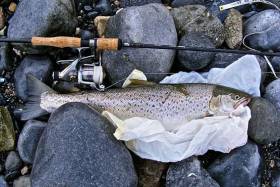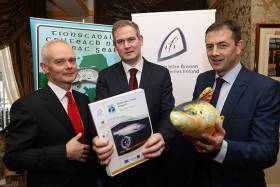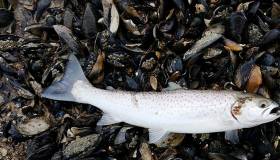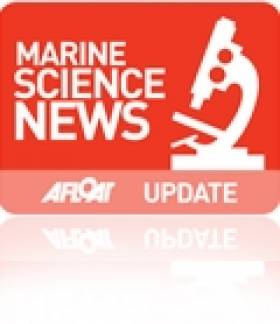Displaying items by tag: Sea Trout
Public Consultation On Sea Trout Policy Development
#Angling - Inland Fisheries Ireland (IFI) is now inviting submissions from the public on the development of a national sea trout policy.
Sea trout in Ireland, in the context of legislation and management, has traditionally been closely identified with salmon and this consultation process will consider the requirement of establishing a separate identity for sea trout.
The policy will make recommendations which will inform a range of issues including sustainable management of stock and any possible legislative changes that may emerge in the future.
Other areas to be addressed will include protection and conservation (including biodiversity, habitat protection and interactions with aquaculture), stock assessment, and education and promotion.
Sea trout, the migratory form of brown trout, leave freshwater as a juvenile fish typically after two years. They enter marine waters where they feed heavily before returning to freshwater, usually to breed with some components of the population spawning several times over their lifetime.
As a result, the sea trout is a valuable angling fish which occurs in most coastal rivers and inshore waters.
Sea trout has significant economic and cultural importance in Ireland with potential for further development. This is coupled with major concerns about sea trout stock declines in some systems nationally, most particularly along the western seaboard, and requires that future management of sea trout is underpinned by a comprehensive policy.
IFI says it recognises the diverse opinions of stakeholders regarding the future management of sea trout and their fisheries and encourages stakeholder engagement through this public consultation process.
Interested parties are invited to make submissions which will be reviewed and considered by the Sea Trout Policy Group, which comprises of a range of representatives with a broad experience of sea trout within IFI.
“The sea trout is a complex migratory fish frequenting freshwater, estuaries and marine waters,” says IFI chief executive Ciaran Byrne. “The biodiversity, economic and cultural value of this type of fish requires a policy direction to manage this precious resource sustainably and to conserve it into the future.
“This public consultation, and ultimately the policy recommendations which will emerge, will capture stakeholder views and incorporate the broad scope of management issues that will underpin future policy.”
The public consultation period will run for five weeks until Wednesday 12 July. All submissions must be made in writing and will be published on the IFI website. Submissions should be marked ‘Public Consultation – Sea Trout Policy’ and can be submitted to [email protected] or by post to:
Sea Trout Policy
Inland Fisheries Ireland
3044 Lake Drive
Citywest Business Campus
Dublin 24
D24 Y265
Information on the consultation is available from the IFI website or from any IFI office.
Inland Fisheries Ireland launches Celtic Sea Trout Project Report following Irish-Welsh Collaboration
Inland Fisheries Ireland has published a new report called The Celtic Sea Trout Project (CSTP) which addresses significant knowledge gaps around sea trout. This migratory trout has a significant fisheries value however some sea trout fisheries in parts of Ireland and the UK bordering the Irish Sea are suffering decline.
The project, which consisted of a multi-agency partnership investigation into sea trout stocks and fisheries of rivers entering the Irish Sea, aimed to address the knowledge gaps, and identify the causes of decline with a view to supporting potential management solutions. Current understanding suggests that the incidence of sea trout and the composition and status of their stocks is sensitive to changes in the environments in which they live. These life history features and the sea trout’s widespread occurrence, make it a unique and potentially sensitive indicator of environmental change.
The structure of the Irish Sea and the variety of rivers draining to it, ranging from the mountainous rivers of West Wales to the lowland rivers of East Ireland, meant there was a wide range of marine and freshwater environments for the study. Funded under the INTERREG IVA Ireland Wales Programme, the Celtic Sea Trout Project was the first project in Ireland and the UK to combine a variety of disciplines in the study of sea trout and their fisheries on a large scale.
Sean Kyne TD, Minister with responsibility for Inland Fisheries said, “I particularly welcome this report and the exemplary collaboration between Irish researchers at Inland Fisheries Ireland and other bodies and their international counterparts. The research has resulted in a better understanding of the Sea Trout stocks in the Irish and Celtic seas and this will underpin logical and well-informed decisions on the management requirements that are needed to safeguard these stocks into the future and to ensure the maximum social and economic contribution is secured”.
Dr Cathal Gallagher, Head of Research at Inland Fisheries Ireland said: “This is a ground-breaking multi-agency partnership investigation which aims to fill some of the information gaps around sea trout conservation. The first study of its kind, the Celtic Sea Trout Project is a wide-scale comprehensive, cross-disciplinary project which has provided valuable insight into many important research needs in this area, which were first identified at the International Symposium on Sea Trout in 2004. Its primary purpose of improving understanding of sea trout stocks in order to support better management in the freshwater and marine environments has been achieved.”
The research will improve the management and long term future of sea trout in the Irish Sea by providing information and advice for management which can be translated into fishery and conservation benefits for countries bordering the Irish Sea. It has also established a wider awareness and long term network of people working to secure the future of sea trout.
Partners in the Celtic Sea Trout Project included: Inland Fisheries Ireland, Bangor University, University College Cork, Natural Resources Wales, the Environment Agency (England), Isle of Man Government, Nith District Salmon Fisheries Board, Galloway Fisheries Trust, Annan District Salmon Fisheries Board and Buccleuth Estate (Border Esk). Subcontractors included APEM Ltd, Cefas and Fishskill Consultancy Services.
The Board of Inland Fisheries Ireland has welcomed new research by scientists from Inland Fisheries Ireland and Argyll Fisheries Trust (Scotland) which found that sea trout carry significantly higher levels of sea lice infestation closer to marine salmon farms. Researchers examined sea lice levels over 25 years from more than 20,000 sea trout. The sea trout were sampled from 94 separate river and lake systems in Ireland and Scotland at varying distances from salmon farms.
The research revealed that sea trout captured closer to salmon farms had significantly higher levels of lice infestation and were found to be of reduced weight. Sea trout are known to remain for extended periods in near-coastal waters where the majority of salmon farms are located. This fish is therefore particularly vulnerable to sea lice impact, having the potential to encounter lice of farm origin throughout much of its marine life.
The effect of the increased lice infestation was most evident in years of less rainfall, when a sea trout of average length (180mm) caught within 10 kilometres of a farm could weigh up to 10g less than fish of similar length caught more than 40 kilometres from a farm. The study covered the entire coasts of West Ireland and Scotland and accounted for variability in temperature and rainfall.
The research article entitled ‘Aquaculture and environmental drivers of salmon lice infestation and body condition in sea trout’ was authored by Dr. Samuel Shephard and Dr. Paddy Gargan of Inland Fisheries Ireland alongside Craig MacIntyre of the Argyll Fisheries Trust. It was published in the international journal Aquaculture Environment Interactions in October.
Studies have shown that the impact of sea lice in farmed areas on sea trout has been substantial with increased mortality, reduced body condition and a changed migratory behavior reported. Heavily liced sea trout return to freshwater prematurely to rid themselves of lice and exhibit very poor marine growth and greatly reduced marine survival. In fact, the most heavily lice infested sea trout die at sea. Rod catch data from 18 Connemara fisheries from 1974 to 2014 show a collapse in rod catch over the 1989/1990 period (see Figure 1). This collapse has been linked to lice infestation from salmon farms while recovery of sea trout rod catches to pre collapse levels has not occurred.
Sea trout offer significant angling value while traditionally the species was abundant on the west coast of Ireland. Angling is worth €836 million to the Irish economy every year and supports upwards of 11,000 jobs, often in rural and peripheral communities. Inland Fisheries Ireland carries out research across fish populations, their habitats and the ecosystem with a view to informing the protection and conservation of this precious resource.
Dr. Paddy Gargan, Senior Research Officer at Inland Fisheries Ireland and one of the report authors, said: “”While there had been some improvement in sea lice control in recent years, lice control on salmon farms was still not sufficient in certain west of Ireland bays during the spring migration period for sea trout to avoid heavy lice infestation and increased marine mortality. More effort is required to ensure lice levels on salmon farms are adequately controlled at this critical period when sea trout leave freshwater and enter the sea.”
Dr. Cathal Gallagher, Head of Research and Development at Inland Fisheries Ireland said: “The finding that salmon farming is responsible for increased sea lice infestation and for significantly reduced body condition in sea trout may have implications for current lice control management strategies. This research will inform coastal zone planning of aquaculture in the future and contribute towards the avoidance of potential impact on sea trout stocks.
Inland Fisheries Ireland is committed to protecting and conserving our fish populations and this research is crucial in managing the sea trout species in Ireland. This country is known as a unique angling destination as a result of its indigenous wild fish species and beautiful scenery. Continued investment in research is necessary to ensure the conservation and protection of our fisheries resource.”
Minister Announces New Sea Trout Tagging Scheme & Conservation Measures
#Angling - Sean Kyne TD, Minister of State at the Department of Communications, Climate Action and Environment, has given statutory notice of his intention to make the Wild Salmon and Sea Trout Tagging Scheme Regulations 2016 to provide for the management of the wild salmon and sea trout fishery by Inland Fisheries Ireland from 1 January 2017.
A copy of the draft regulations is available from the department website and and is also open for public inspection at the offices of the department in Cavan and at the offices of Inland Fisheries Ireland.
Any person may submit observations or objections to the draft regulations at any time during the period of 30 days concluding on 11 December 2016 either by e-mail to [email protected] or to the following address:
Inland Fisheries Division,
Department of Communications, Climate Action and Environment,
Elm House,
Earlsvale Road,
Cavan Town
H12 A8H7
Ireland
Tel: 01 6783071 / Lo-call 1890 449 900 Extension 3071
All submissions received will be published on the department's website following the conclusion of the consultation period.
82 Rivers Open For Salmon Angling In 2016
#Angling - Minister of State Joe McHugh has approved a suite of regulations and bye-laws that will govern the wild salmon and sea trout fisheries in the New Year, coming into effect from Friday 1 January.
Minister McHugh said 50 rivers will be fully open and this will provide opportunities for all to share this important natural resource on a sustainable basis. A further 32 will be open for angling on a catch and release basis.
In all, 82 rivers will open for angling activity in 2016 - one fewer than in 2015.
Minister McHugh received management advice in relation to 146 genetically individual wild salmon stocks in Ireland from Inland Fisheries Ireland (IFI) before making a final decision.
This advice was also made available publicly as part of a public consultation process and was based on the scientific assessment of the current status of all stocks carried out by the independent Standing Scientific Committee on Salmon.
The committee comprises scientists from IFI, Bord Iascaigh Mhara (BIM), the Marine Institute, the Loughs Agency, the National Parks and Wildlife Service (NPWS), the Agri-Food and Biosciences Institute (AFBI- Northern Ireland) other State bodies and third level institutions.
Thirteen submissions were considered as part of the public consultation process which closed on 10 December.
In all, the Independent Standing Scientific Committee for Salmon (SSCE) assessed 146 rivers/estuaries/harbours and has advised that:
- 50 rivers are open as a surplus of fish has been identified in these rivers.
- 32 rivers are classified as open for “catch and release” angling.
- 64 rivers are closed as they have no surplus of fish available for harvest.
The Wild Salmon and Sea Trout Tagging Scheme Regulations for 2016 are in essence unchanged from the Regulations which were introduced for 2015.
Draft Wild Salmon & Sea Trout Tagging Regulations Open For Consultation
#Angling - Minister of State at the Department of Communications, Energy and Natural Resources Joe McHugh has given statutory notice of his intention to make the Wild Salmon and Sea Trout Tagging Scheme Regulations 2015.
The new Statutory Instrument will provide for the management of the wild salmon and sea trout fishery by Inland Fisheries Ireland from 1 January 2016.
A copy of the draft regulations is available online and is open for public inspection at the offices of the department in Cavan and also at the offices of Inland Fisheries Ireland.
Any person may submit observations or objections to the draft regulations at any time during the period of 30 days concluding on 10 December 2015 to
Inland Fisheries Division,
Department of Communications Energy and Natural Resources,
Elm House,
Earlsvale Road,
Cavan Town,
H12 A8H7,
Ireland
or by e-mail to [email protected].
All submissions received will be published on the department's website following the conclusion of the consultation period.
For more call 01 678 2117 or Lo-call 1890 44 99 00 (Extension). Rates charged may vary between service providers.
Salmon Farms Can Have Significant Impact on Wild Salmon & Sea Trout Stocks
A definitive scientific paper, reviewing over 300 scientific publications, has just been published in the prestigious journal Aquaculture Environment Interactions on the effects of sea lice on sea trout stocks. A team of top international scientists from Norway, Scotland and Ireland reviewed all available published studies on the effects of sea lice and have concluded that sea lice have negatively impacted wild sea trout stocks in salmon farming areas in Ireland, Scotland and Norway.
The paper entitled “Effects of salmon lice Lepeophtheirus salmonis on wild sea trout Salmo trutta—a literature review” (https://research-repository.st-andrews.ac.uk/handle/10023/7295) reached its conclusions based on comprehensive studies of the effects of salmon lice from over 300 scientific publications. The project was funded by the Norwegian Seafood Research Fund which provides investment in Norwegian seafood industry-based R&D with the objective of creating added value for the seafood industry.
The study also examined the potential effect of sea lice on salmon and concluded that sea lice have a potential significant and detrimental effect on marine survival of Atlantic salmon with potentially 12-29% fewer salmon spawning in salmon farming areas. These conclusions concur with previously published Inland Fisheries Ireland (IFI) research on the potential impact of sea lice from marine salmon farms on salmon survival.
The studies reviewed indicate that salmon farming increases the abundance of lice in marine habitats and that sea lice in intensively farmed areas have negatively impacted wild sea trout populations. The effects of sea lice on sea trout are increased marine mortality and reduced marine growth. This new study confirms the evidence collected since the early 1990’s in Ireland regarding the impact of sea lice on wild sea trout stocks, particularly in relation to the collapse of Connemara’s sea trout stocks.
IFI have consistently called for marine salmon farms to maintain sea lice levels close to zero prior to and during the wild sea trout and salmon smolt migration period in spring. IFI have also raised concerns regarding the location of salmon farms in the estuaries of salmon and sea trout rivers.
The Board of Inland Fisheries Ireland welcomed this important publication and commented: “This new scientific review paper confirms the need for very tight regulation of sea lice levels on salmon farms and raises legitimate concerns with regard to the potential impact of new large scale salmon farms proposed along Irelands west coast on salmon and sea trout stocks. Regulators will now need to consider the results of this comprehensive review when making decisions on the sustainability and approval of future marine salmon aquaculture licences and the regulation of sea lice at existing sites so as to ensure no negative impact on salmon and sea trout stocks.”
Registration Open For International Sea Trout Symposium
#MarineScience - The second International Sea Trout Symposium will take place in Dundalk, Co Louth from 20-22 October 2015.
Targeted at scientists, managers and other fishery stakeholder interests in the public and private sectors, the central aim is to promote the wider application of an evidence-based approach to the future management and regulation of the sea trout and to ensure that its often very special needs become fully integrated into catchment management plans and environmental impact assessments.
This major event will build on the success of the first International Symposium on the ‘Biology, Conservation & Management of Sea Trout’ held in Cardiff, Wales in 2004. Its overall objective will be to promote the application of the latest science to the better management of sea trout stocks and their associated fisheries.
It will consider developments since the previous symposium, highlight the implications of the strategic gaps in our knowledge that currently limit our ability to manage the resource effectively and review priorities for future investigation.
The symposium is aimed at fishery scientists, managers, policy makers and other interested parties. It is planned to provide practical guidance to assist managers and regulators in the sustainable management of the sea trout resource and to ensure that they are fully integrated into any assessment of the impact of other policies, regulations and developments affecting their aquatic environment. While primarily focused on migratory sea trout, it will include non-migratory trout and other anadromous species where relevant.
Symposium topics will include:
- Understanding Anadromy
- Populations & Management
- Movements & Migration
- Ecology & Behaviour
- Monitoring & Surveillance
- Threat Assessment
- Future management and research
Rates for the symposium start at €70 for the daily attendance package, with a basic three-day delegate package priced at €230 and the full package (including the gala dinner and a copy of the proceedings) at €330. A student delegate package for PhD and MSc candidates is available for €150.
The closing date for registrations is 4 September 2015. Details of the programme, accommodation and travel are available at the Sea Trout Symposium website.
Revised Wild Salmon and Sea Trout Tagging Scheme Regulations In 2015
#Angling - Minister for Natural Resources Alex White has given statutory notice of his proposal to revise the Wild Salmon and Sea Trout Tagging Scheme Regulations to apply from 1 January 2015.
The minister proposes to revoke the existing tagging scheme regulations and to make revised regulations to provide for commercial and angling total allowable catches on an individual river basis.
The draft regulations are available for public inspection HERE.
Any person may submit objections to the draft regulations at any time during the period of 30 days that commenced on Tuesday 11 November 2014 addressed to Inland Fisheries Division, Department of Communications Energy and Natural Resources, Elm House, Earlsvale Road, Cavan or by e-mail to [email protected].
Inland Fisheries Ireland Opens New Research Facility in Galway
#MarineScience - Inland Fisheries Ireland (IFI) has officially opened a new laboratory at its research facility on its National Index Sea Trout Catchment (River Erriff) at Aasleagh Lodge in Leenane, Co Galway.
IFI says it will continue to invest resources in the Erriff research station, as the outputs from research conducted here will be vital for the future conservation and management of sea trout.
International sea trout expert Dr Graeme Harris, who gave the keynote address at the launch, congratulated IFI on its renewed focus on sea trout and emphasised the importance of world class science on this iconic species.
While research and data collection on both salmon and sea trout has taken place at the Erriff research facilities for over 30 years, a significant new research programme was initiated at the Erriff in 2014.
This new study, which saw the release of sea trout fitted with acoustic tags to sea, aims to investigate migration, distribution, habitat usage and survival of sea trout and salmon smolts in the marine environment on the west coast of Ireland.
Speaking at the launch, IFI chief executive Dr Ciaran Byrne said his organisation "is committed to applied scientific research that is designed to answer important conservation and management questions.
"We have prioritised research on sea trout and are fortunate to have these excellent facilities at this location. We rely on excellent data and scientific analysis which informs future management decisions.”
The Erriff fishery is located at the head of Killary Harbour near the village of Leenane in Connemara. The fishery was purchased by the Irish State from Lord Brabourne in 1982 and has since operated as a salmon and sea trout angling and research fishery.
The river has a large lake in its headwaters, Tawnyard Lough, and a downstream fish trap has operated at the lake exit since 1983. This facility allows assessment of sea trout stocks on an annual basis.



































































